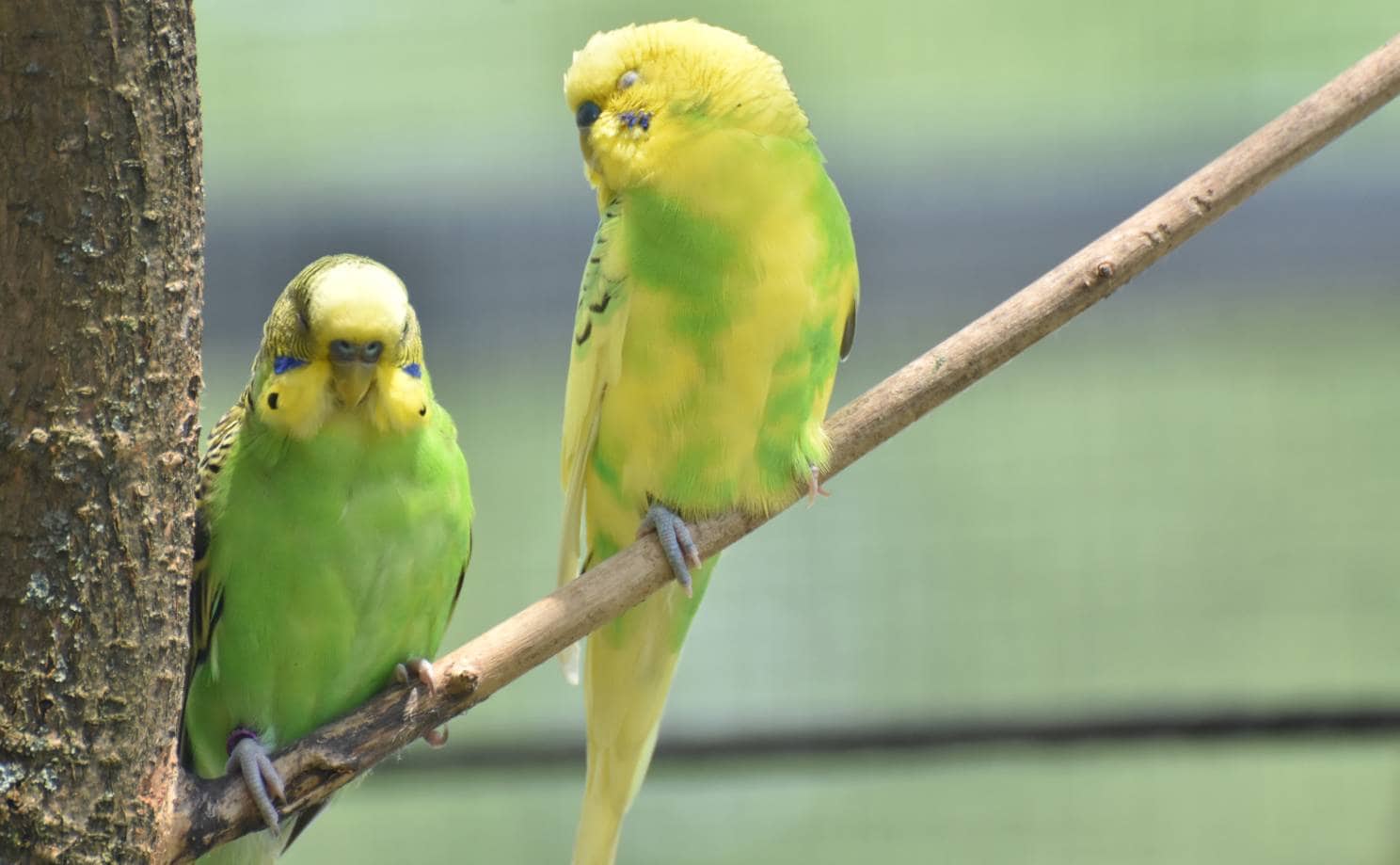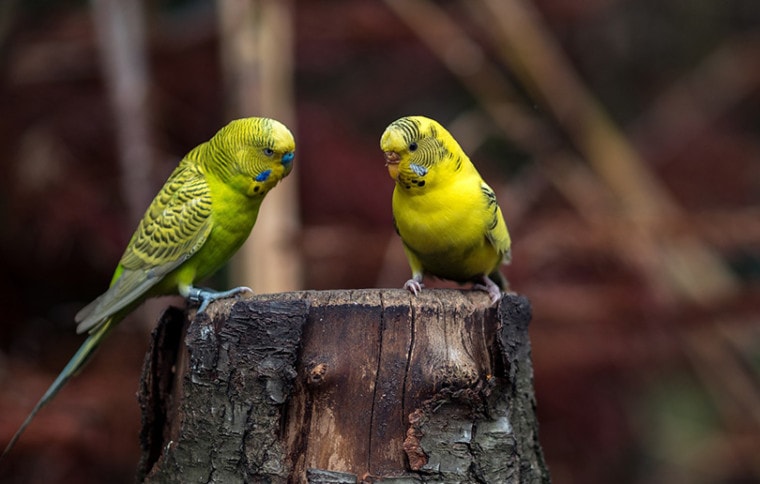
Looking for an animal companion but live in a space that’s just a touch too small for a dog or cat? You might consider getting a small bird then. Not only can they be just as fun and affectionate as the more common dog or cat, but they tend to be less expensive pets, making them especially good for first-time pet owners. Plus, they definitely take up less space than larger animals.
Small birds will come with tons of personality and quirks—and though each bird will be unique, it’s essential to know a bit about the temperament and care of the bird species you’re considering getting. If you haven’t quite figured out which species will work best for you, let us introduce you to six small birds that make amazing pets, so that you can decide!

Top 6 Small Pet Birds
1. Budgie
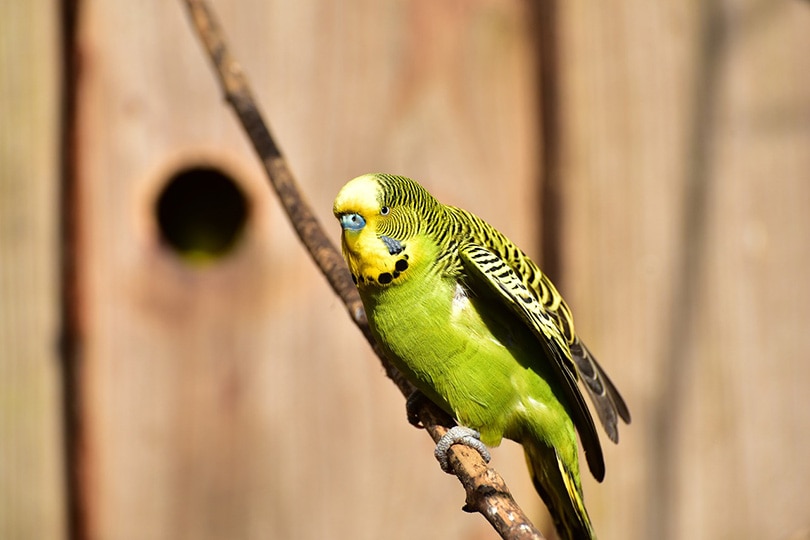
The Budgerigar, otherwise known as a budgie, is a subspecies of the parakeet and, quite possibly, the most popular bird to have as a pet. A teensy bird with a huge personality, this colorful pet is intelligent and active. They can also be talkers (at least, if you teach them words or they manage to pick up some via listening).
This bird is very hands-on; you either need to spend plenty of time with them so they don’t get lonely or get them a budgie friend. They’re very active 1 —you might find them bouncing around their cage and engaging in some chaos — and love to play with toys, so make sure you have plenty on hand.
Whether you have a single budgie or more than one, you’ll need a fairly large cage 2. For one budgie, you’ll need one that’s at least 18” x 18” x 18”. For two, you’ll require one that’s at least 30” x 18” x 18”.
The budgie can live anywhere between 5 and 12 years 3, depending on how well it’s cared for.
2. Canaries
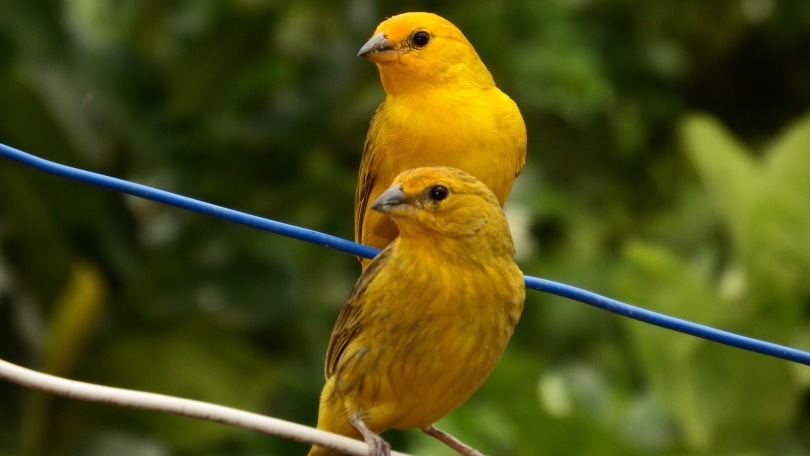
These bright birds are a member of the finch family and originated in the Micronesian Islands 4. They’re not just pretty to look at, what with their yellow, white, red, or brown and yellow feathers, though. Male canaries are known for being exceptional signers (females, not so much, but they make up for it with lots of chirping).
This bird is one to have a more hands-off approach with, as they aren’t fond of being handled. However, if you put in the time, you can train them to be comfortable with perching on you. Overall, they’re relatively low-maintenance birds, mostly requiring a large cage — that sits somewhere you’ll spend a lot of time in — so they can fly around.
You can make do with a single one of these birds, as they don’t require (nor particularly care for) bird companionship. If you do decide to get more than one, you’ll need to cage them separately — especially males, as they are quite territorial — in a cage that’s at least 16” x 30” 5. And don’t keep males and females together unless you want to become a parent to baby birds!
These birds will live anywhere from 10-15 years 6.
3. Cockatiels
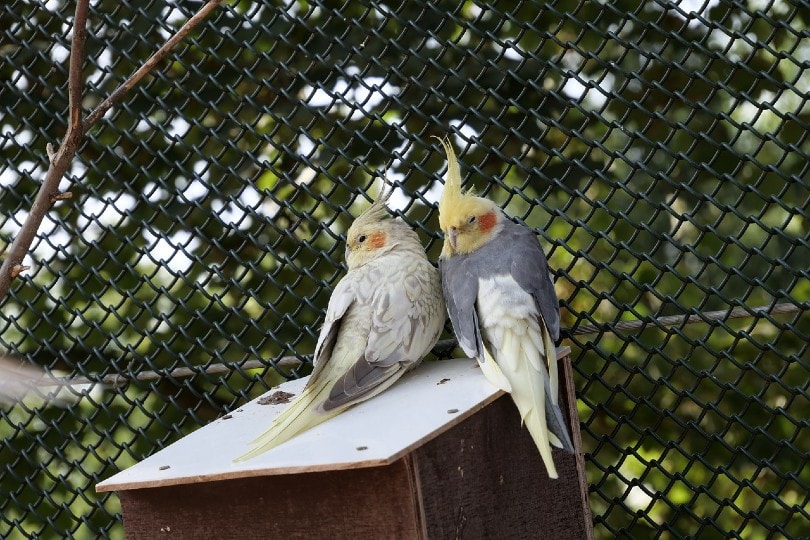
Cockatiels, a native of Australia 7, are one of the more popular pet birds in the U.S. These birds are incredibly chill and friendly; they even make good cuddle buddies due to their powder down 8 that keeps their feathers super soft! Start them early with getting used to people, and you’ll have a loyal friend in no time.
This bird species likes to whistle (although they don’t do it excessively), with males being more prone to vocalizations. Getting a single one of these birds is fine, but if you’re not home a lot, you may want to get two, so they can keep each other entertained. And, if you do get more than one, they can live in the same cage — provided the cage is large and has plenty of room for them to move around. Even a single cockatiel will need a cage that’s about 24” x 24” x 24”.
Cockatiels have a lifespan that’s anywhere between 15 and 25 years.
If you’re new to the wonderful world of cockatiels, you’ll need a great resource to help your birds thrive. We highly recommend taking a closer look at The Ultimate Guide to Cockatiels, available on Amazon.

This excellent book covers everything from the history, color mutations, and anatomy of cockatiels to expert housing, feeding, breeding, and health care tips.
4. Finch
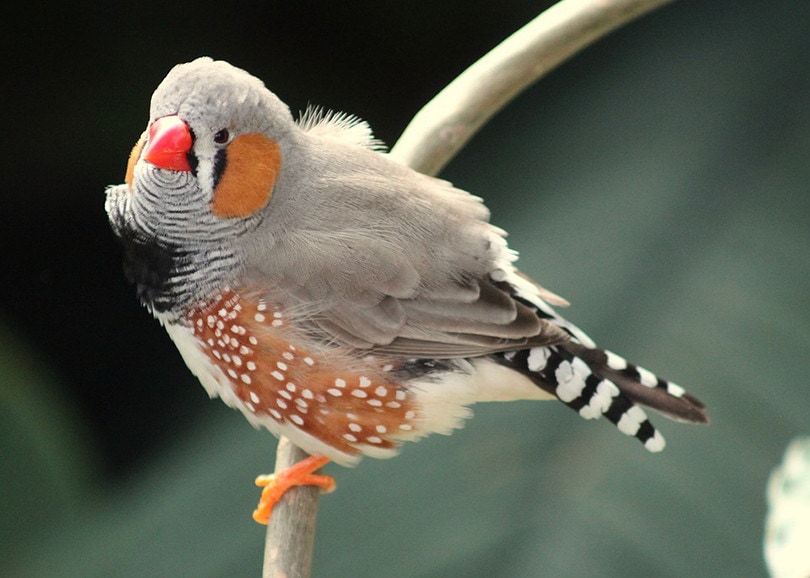
Finches are a bird that have been kept as a pet for a long time. The first finch to be domesticated was likely a Bengalese or Society. A cousin of the canary, this bird is more suitable for those who like birds but don’t necessarily want to handle them. They can be quite skittish and usually prefer the company of other finches over that of people.
This skittishness doesn’t mean they don’t make good pets, though. They can bring plenty of fun to your home with their bright colors, personalities, and vocalizations. You shouldn’t get just a single finch, however. While they may not love human interaction, they are very social and need plenty of other interaction. Getting a flock of three to five finches will keep these birds happy.
Even though these birds are itsy bitsy, they’ll still need a large cage to stay in together. For example, a pair of finches would need at least 18” x 24” x 18” of space. For four finches, you’d need to double that. However, you should know there are several different types of finches, and some may not get along well. Be sure to check which ones will be okay living in a cage together before you get a flock.
Finches will live between 4-7 years.
5. Green-Cheeked Conure
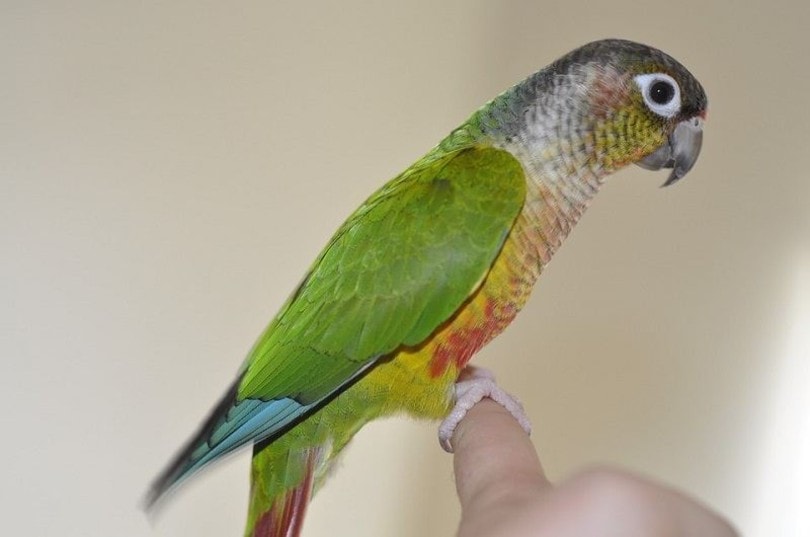
The Green-Cheeked Conure, a native of South America, is of the parrot species and has started becoming more popular as pets. They are active and playful, as well as affectionate and cuddly. However, they do require lots of attention, or you’ll have a bored bird who develops behavioral issues such as feather picking.
They are surprisingly quiet given their energy levels and aren’t known for talking, but they may learn a few words over time. Be prepared to spend plenty of time playing with them! Plus, make sure they have a variety of toys on hand to entertain themselves too.
As long as you’re giving them enough attention, the Green-Cheeked Conure will do fine as a single bird. However, if you feel you won’t be around enough for one, you want to get two, so they have a buddy. Just don’t pair these birds up with other species as they may not get along. A cage for a single Green-Cheeked Conure should be around 24” x 24” x 24” .
This bird can live up to 30 years, so if you’re looking for a pet that will be around for a long while, this one could be for you!
6. Lovebirds
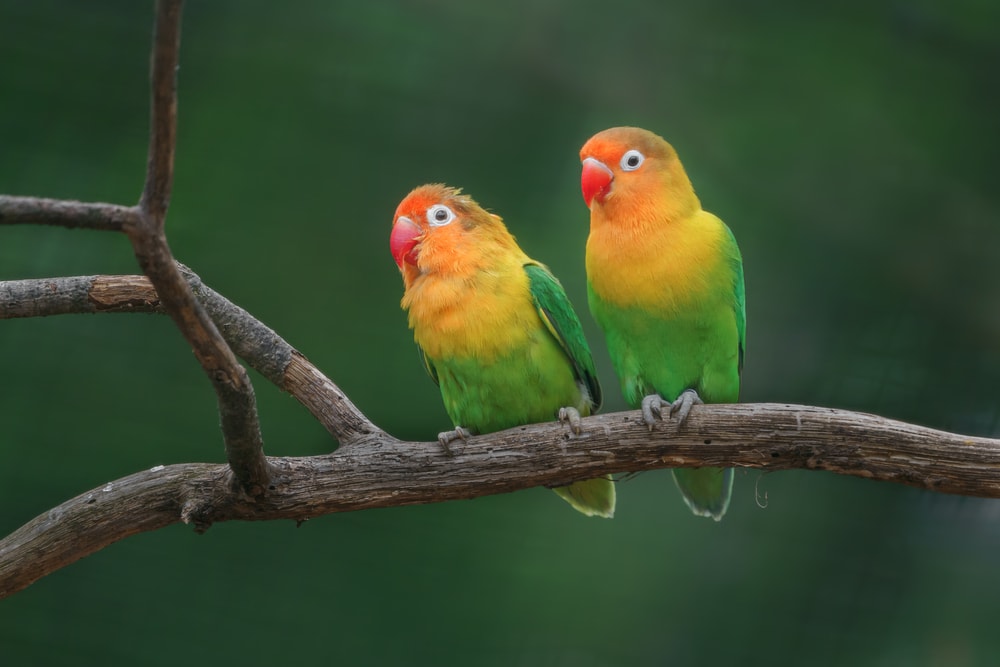
Lovebirds, also known as “pocket parrots”, are probably familiar to you. These birds are called “lovebirds” because of their propensity to develop strong, monogamous bonds with their mates.
Because of this, the lovebird will do better in pairs, but if you spend a lot of time with them, a single one should be okay on its own. However, these birds are very social creatures and don’t enjoy being by themselves. Leave them alone too often, and behavioral issues will likely occur. Lovebirds will need a large cage — the recommendation for a pair is 32” x 20” x 20”.
They are a low-maintenance bird to have, other than their need for attention, making them an excellent bird starter pet. Just be prepared for plenty of chatter, as they are quite vocal!
Lovebirds can live anywhere from 10-12 years.

How To Take Care of Small Pet Birds
While individual small pet birds will have slight differences in their care, they’ll also have many similarities. The basics of caring for a small pet bird will include the below.

Basic Needs
All small pet birds will require a large cage, so they have plenty of room to play and fly around. A cage that is approximately twice the wingspan of your bird is a good rule of thumb. (Of course, if you’re housing more than one bird, you’ll need to make the cage larger.) You’ll also want to pick a cage that is rectangular, as oval-shaped cages can be unhealthy due to the lack of flying space. Don’t place your cage in an isolated area—birds need your company!
Line the cage with newspaper or something similar to make waste removal simpler. You’ll also need to include perches and toys in your bird’s cage so that they can stay active. Also required will be a bird feeder and a place for fresh water.
Birds love to bathe, and you can make doing this easier for them by placing a small birdbath in their cage. You can also let them join you in the shower or let them play in the sink. Some birds will even be happy to be misted with a water bottle a few times a week.
Birds will need regular time outside their cage to fly and explore. Be sure any windows and doors are closed off before you let them out to play, though!
Diet
While there may be minor variations amongst the diets of small pet birds, for the most part, your bird will get their needed nutrients with a mix of around 75% pellets and 25% food such as fruits and veggies. Different birds will like different fruits and veggies, but some of the kinds you can try with your pet bird include berries, bananas, apples and corn, peas, broccoli, leafy greens, and carrots.
Any fresh foods should be rinsed off before being given to your bird, while pellets should be changed out daily. Foods to avoid with your bird include coffee, avocado, and chocolate — these are toxic! Also needed will be a constant supply of fresh water.

Conclusion
Small birds can make wonderful pets for those who aren’t fond of our furry friends or don’t have the living space for larger animals. Depending on the species you get, they can be equally affectionate, cuddly, and playful as any cat or dog. And there are so many types of small birds out there! The ones listed here are some of the more popular ones kept as pets, and all are fairly easy to care for. Just make sure you’re prepared with the necessities and correct food before getting your bird. Also, be sure you know whether one will suffice or whether you’ll need to get multiple birds to keep them happy. Then, enjoy your time with your new pet!
Featured Image Credit: bildgebende_Momente, Pixabay

